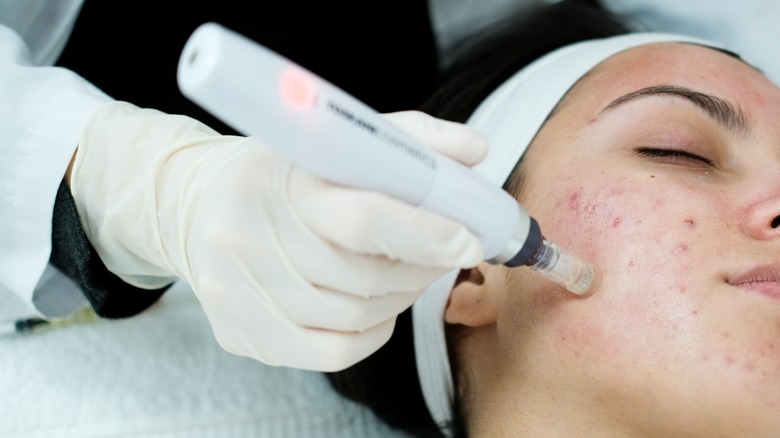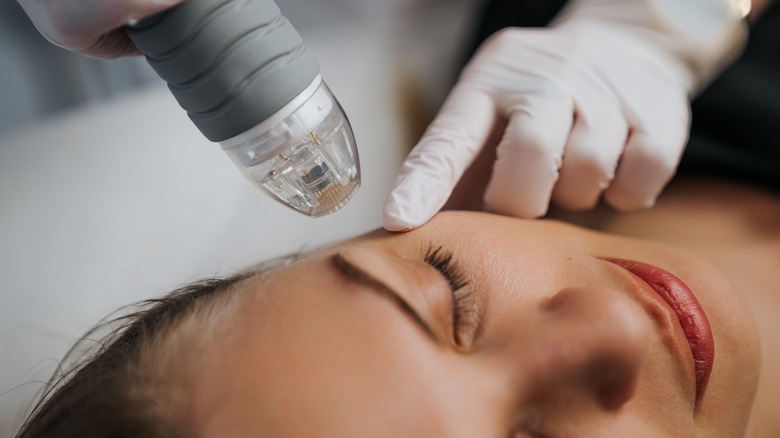Your Guide To Exosomes, The Skincare Trend Set To Takeover 2024
Exosomes, a staple of the K-beauty world, have become increasingly popular in 2024's skincare trends around the world. Exosomes are nanovesicles produced by cells that are full of lipids, proteins, amino acids, and genetic material. They circulate throughout the bloodstream, and source out aging cells that are in need of extra help. Research published in the 2023 journal Cosmetics explained that exosomes offer "cell-to-cell communication," and aid the aging cell in producing more collagen, elastin, and reduce inflammation. These are all things that young cells do quickly and easily, so exosomes help stimulate and re-energize sluggish cells.
"Think of an exosome as an envelope with instructions inside — like one cell mailing a letter to another cell and telling it what to do," professor of molecular biomedical sciences Ke Cheng explained in research published by Science Daily. This study found that exosomes were far more effective than retinol at precipitating cell turnover and collagen production. This is big news in the skincare world, because up until now, retinol has been the unrivalled choice to obtain these anti-aging benefits. Now it looks like exosomes might swoop in and claim that title.
However, exosome therapy is a lot more complicated than topical retinoids or other anti-aging heroes, like copper peptides or the anti-oxidant favorite chebula. Exosomes must be applied in conjunction with a treatment, like laser therapy. Its harvesting story is also complicated, so there's a lot to know about this new, scientific approach to renewing cells.
What can exosome therapy do for your skin?
Exosome therapy essentially makes your cells act younger. After the age of 20, cells produce less collagen and elastin, and cannot regenerate as quickly. This, in turn makes skin show the typical signs of aging; sagging, wrinkles, and a loss of its luminous elasticity. The number of exosomes naturally floating in the bloodstream also declines as we age. That said, the idea behind exosome therapy is that allegedly, introducing more exosomes can reverse that process. "We've seen that [exosomes] have anti-inflammatory and regenerative properties and signal cells to do things they're supposed to do—like make more collagen. It leads to an improvement in skin texture, thickness, and quality," plastic and reconstructive surgeon Catherine Chang, MD, told Elle.
However, don't expect to see results immediately. Exosome treatment is a long-term plan. "You can expect brighter, smoother skin, but it is also normal to see a reduction in inflammation like rosacea or acne," laser and skin expert Debbie Thomas told Glamour. "Skin feels better as it retains moisture more effectively and will become stronger and healthier. On the whole, because the treatment is stimulating your own natural processes, it will take 3-6 weeks to start to see results after the first session." Exosomes have even been used to stimulate hair growth and heal ruptured skin around wounds. However, as president of the American Society of Plastic Surgeons Steven H. Williams, MD, told Elle, there is still much more research needed on exosomes, and much of the research is still pre-clinical.
Who is a good candidate for exosome treatment?
Because exosomes are a naturally-occuring nanovesicles in our bodies, the treatment is suitable for everyone. On top of that, because exosome treatment offers such a wide-ranging array of benefits, people with all sorts of differing skin concerns can benefit from it. Board-certified dermatologist Ramya Garlapati, MD, told Allure: "Individuals who are looking for a new anti-wrinkle treatment and overall skin rejuvenation can see improvement with this procedure, as well as those with uneven texture or a dull complexion, acne scars, enlarged pores, and unwanted pigmentation." Basically, the message is that the effects of exosome therapy will be must more mild – soothing, in fact – after the abrasions of microneedling or laser therapy.
Since exosome therapy must be done after a laser or microneedling appointment, it's considered an efficacious booster to these other treatments. "I have patients who say, 'I've gotten lasers done and didn't see great improvement, but I don't want to do filler or Botox. I'm looking for more natural but enhanced improvement,'" board-certified dermatologist Marina Peredo, MD, told Allure. Exosome therapy has trumped the popular platelet-rich plasma (PRP) therapy, in which platelets are spun and re-injected in the patient. The issue is that as people age, the anti-aging properties in their blood also diminishes, and the treatments are less effective. Since exosomes are derived from sources outside of one's body – from donors or plants – this isn't an issue.
Exosome treatments are only offered by professionals
You can't just buy a serum of exosomes and apply it topically. In fact, exosomes placed on the outermost layer of the skin will actually do nothing. It's an in-office treatment exclusively, which means that it's on the pricey side. A dermatologist or specialist first must perform a treatment like microneedling or resurfacing laser therapy. The micro-puncturing from these treatments create pathways in the skin; the specialist then applies the exosomes through a gel on the skin, and the exosomes can reach stagnant cells and reinvigorate collagen and elastin production. Since the exosome gel is cold, it can help alleviate some of the discomfort of the previous treatment, and since exosomes are essentially repairing nanovesicles, they help heal the redness and discomfort caused by the laser treatment.
Prices for exosome therapy vary depending on what other treatment you chose to precede it; exosome treatment alone typically costs around $295, but since it must be combined with laser therapy or microneedling, the total is closer to $800-$1000. However, the results can last up to eight months, so people have reported a need for fewer treatments.
Exosomes are harvested from the human body – fat, umbilical chords, and bone marrow – but in some parts of the world, it's illegal to use human-sourced exosomes, so some dermatologists harvest them from plants. In the United States, dermatologists do use human-derived exosomes, but it's important to note that this treatment is not yet FDA approved.



